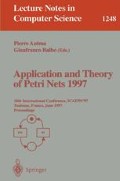Abstract
A model, called Place Chart Nets (PCN), is presented. It allows the modeling of both asynchronicity and exception handling (preemption). Contrary to State Charts and other reactive models, which are inherently synchronous, PCNs specify a system behavior using partial orders. Contrary to Petri nets, PCNs have a notion of hierarchy. Contrary to other hierarchical models based on Petri net extensions, the hierarchy in PCNs is determined by preemption. We show that PCNs are a non-trivial generalization of classical PNs, in the sense that (1) for the finite (bounded) case modeling a PCN may require an exponentially larger PN, (2) for the infinite (unbounded) case the class of PCN languages properly includes the class of PN languages and (3) boundedness of PCNs is decidable. Then we present synthesis of safe PCNs from transition systems, which generalizes the theory of regions previously developed for PNs.
Preview
Unable to display preview. Download preview PDF.
References
A. Arnold. Finite Transition Systems. Prentice Hall, 1994.
E. Badouel, L. Bernardinello, and Ph. Darondeau. Polynomial algorithms for the synthesis of bounded nets. Technical Report 2316, INRIA, RENNES Cedex, France, 1994.
L. Bernardinello and F. De Cindio. A survey of basic net models and modular net classes. In Lecture Notes in Computer Science, volume 609, pages 304–351, 1992.
L. Bernardinello, G. De Michelis, K. Petruni, and S. Vigna. On synchronie structure of transition systems. Technical report, Universita di Milano, Milano, 1994.
G. Berry, P. Couronné, and G. Gonthier. The synchronous approach to reactive and realtime systems. IEEE Proceedings, 79, September 1991.
J. Buck, S. Ha, E.A. Lee, and D.G. Messerschmitt. Ptolemy: a framework for simulating and prototyping heterogeneous systems. Interntional Journal of Computer Simulation, special issue on Simulation Software Development, January 1990.
J. Cortadella, M. Kishinersky, L. Lavagno, and A. Yakovlev. Synthesizing Petri nets from state-based models. In Proceedings of the International Conference on Computer-Aided Design, pages 164–171, November 1995.
J. Cortadella, M. Kishinevsky, L. Lavagno, and A. Yakovlev. Deriving Petri nets from finite transition systems. Technical Report UPC-DAC-1996-19, Dept. of Computer Architecture, Universitat Politècnica de Catalunya, June 1996.
J. Desel and W. Reisig. The synthesis problem of Petri nets. Technical Report TUM-I9231, Technische Universität München, September 1992.
D. Drusinski and D. Harel. On the power of bounded concurrency. I. Finite automata. Journal of the Association for Computing Machinery, 41(3):517–539, May 1994.
A. Ehrenfeucht and G. Rozenberg. Partial (Set) 2-Structures. Part I, II. Acta Informatica, 27:315–368, 1990.
A. Giua. Petri Net techniques for supervisory control of discrete event systems. In Proc. of the First International Workshop on Manufacturing and Petri Nets, pages 1–30, Osaka, Japan, June 25, 1996.
N. Halbwachs. Synchronous Programming of reactive systems. Kluwer Academic Publishers, 1996.
David Harel. Statecharts: A visual formalism for complex systems. Science of Computer Programming, 8(3):231–274, June 1987.
T. Holvoet and P. Verbaeten. Petri Charts: an alternative technique for hierarchical net construction. In IEEE Conference on Sytems, Man and Cybernetics, 1995.
J. E. Hopcroft and J. D. Ullman. Introduction to Automata Theory, Languages and Computation. Addison-Wesley, 1979.
M. Jantzen. Language theory of Petri nets. In Advances in Petri Nets 1986, Lecture Notes in Computer Science, Vol. 254-I, pages 397–412. Springer-Verlag, 1987.
R. M. Karp and R. E. Miller. Parallel program schemata. Journal of Computer and System Sciences, 3:147–195, 1969.
M. Kishinevsky, J. Cortadella, A. Kondratyev, L. Lavagno, A. Taubin, and A. Yakovlev. Place Chart Nets. Technical Report 96-2-003, University of Aizu, Japan, November 1996.
M. Kishinevsky, A. Kondratyev, A. Taubin, and V. Varshavsky. Concurrent Hardware: The Theory and Practice of Self-Timed Design. John Wiley and Sons, London, 1993.
M. Nielsen, G. Rozenberg, and P.S. Thiagarajan. Elementary transition systems. Theoretical Computer Science, 96:3–33, 1992.
J. L. Peterson. Petri Net Theory and the modeling of systems. Prentice-Hall, Inc., 1981.
C. Rackoff. The covering and boundedness problem for vector addition systems. Theoretical Computer Science, 6:223–231, 1978.
L. E. Rosier and H. C. Yen. A multiparameter analysis of the boundedness problem for vector addition systems. Journal of Computer and System Sciences, 32:105–135, 1986.
R. Valk. On processes of object Petri nets. Technical Report 185/96, University of Hamburg, Computer Science Department, 1996.
Author information
Authors and Affiliations
Editor information
Rights and permissions
Copyright information
© 1997 Springer-Verlag Berlin Heidelberg
About this paper
Cite this paper
Kishinevsky, M., Cortadella, J., Kondratyev, A., Lavagno, L., Taubin, A., Yakovlev, A. (1997). Coupling asynchrony and interrupts: Place Chart Nets. In: Azéma, P., Balbo, G. (eds) Application and Theory of Petri Nets 1997. ICATPN 1997. Lecture Notes in Computer Science, vol 1248. Springer, Berlin, Heidelberg. https://doi.org/10.1007/3-540-63139-9_44
Download citation
DOI: https://doi.org/10.1007/3-540-63139-9_44
Published:
Publisher Name: Springer, Berlin, Heidelberg
Print ISBN: 978-3-540-63139-2
Online ISBN: 978-3-540-69187-7
eBook Packages: Springer Book Archive

